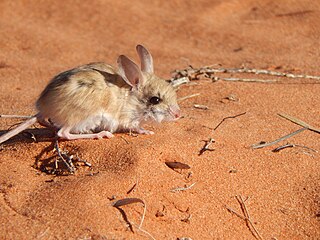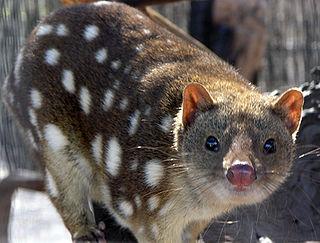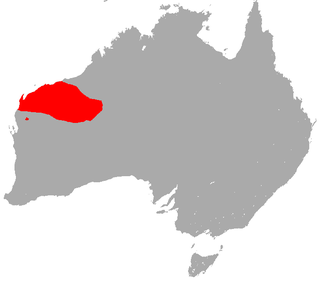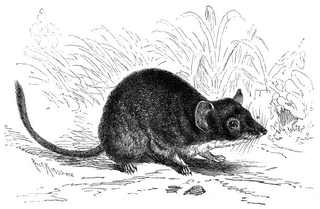
The dusky hopping mouse, is a small rodent endemic to Australia, inhabiting desert regions characterised by sand dunes. Populations have experienced significant declines since the arrival of Europeans, and continue to be subject to threatening processes. It is currently listed as a threatened species.

The Dasyuridae are a family of marsupials native to Australia and New Guinea, including 71 extant species divided into 17 genera. Many are small and mouse-like or shrew-like, giving some of them the name marsupial mice or marsupial shrews, but the group also includes the cat-sized quolls, as well as the Tasmanian devil and the extinct thylacine. They are found in a wide range of habitats, including grassland, underground, forests, and mountains, and some species are arboreal or semiaquatic. The Dasyuridae are often called the 'marsupial carnivores', as most members of the family are insectivores.

The common planigale, also known as the pygmy planigale or the coastal planigale, is one of many small marsupial carnivores known as "marsupial mice" found in Australia. There they fill a similar niche to the insectivores of other parts of the world.

The brush-tailed phascogale, also known by its Australian native name tuan, the common wambenger, the black-tailed mousesack or the black-tailed phascogale, is a rat-sized arboreal carnivorous marsupial of the family Dasyuridae, characterized by a tuft of black silky hairs on the terminal portion of its tail. Males of this species do not live past the age of one, as they die after reproducing.

The kowari, also known by its Diyari name kariri, is a small carnivorous marsupial native to the gibber deserts of central Australia. It is the sole member of the genus Dasyuroides.

The subfamily Dasyurinae includes several genera of small carnivorous marsupials native to Australia: quolls, kowari, mulgara, kaluta, dibblers, phascogales, pseudantechinuses, and the Tasmanian devil. The subfamily is defined largely on biochemical criteria.

Mulgaras are the six small rat-sized species in the genus Dasycercus. They are marsupial carnivores, closely related to the Tasmanian devil and the quolls, that live in deserts and spinifex grasslands of arid Australia. They are nocturnal, but occasionally "sunbathe" in the entrance of the burrow in which they dwell. Their kidneys are highly developed to excrete extremely concentrated urine to preserve water, as the animals rarely drink. They feed mostly on insects, but also eat reptiles and small mammals. They are seasonal breeders and breed from June to September. The pouch comprises two lateral folds of skin.

The little red kaluta is a small, reddish-brown, shrew-like mammal native to dry grasslands of northwest Australia. It is active at night, feeding on insects and other small animals. The kaluta is a marsupial and is the only member of its genus, Dasykaluta. Individuals are around 10 cm (3.9 in) long and weigh from 20 to 40 g. They live for about four years in captivity. Other common names include little red antechinus, russet antechinus and spinifex antechinus.

The tribe Dasyurini includes several genera of small carnivorous marsupials native to Australia: quolls, kowari, mulgara, kaluta, dibblers, neophascogales, pseudantechinuses, and the Tasmanian devil.

The Phascogalini are a tribe in the family Dasyuridae, comprising seven genera of small marsupials native to Australia and New Guinea.

The crest-tailed mulgara, is a small to medium-sized Australian carnivorous marsupial and a member of the family Dasyuridae which includes quolls, dunnarts, the numbat, Tasmanian devil and extinct thylacine. The crest-tailed mulgara is among a group of native predatory mammals or mesopredators endemic to arid Australia.

The brush-tailed mulgara, previously the mulgara Dasycercus cristicauda is a medium sized carnivorous Australian marsupial species weighing approximately 100 g (3.5 oz). The brush-tailed mulgara is sexually dimorphic with males being much larger than females. Their body length is 12 to 17 cm, and tail length is 6–10 cm (2.4–3.9 in). They store fat in their tail which at times can be over 16 mm (0.63 in) wide at the base.
Patricia Woolley is Australian zoologist recognised for her work with marsupials, specifically the dasyurid family. Pseudantechinus woolleyae is named for her.
The southern mulgara is a newly described, potentially extinct, species of mulgara. The species is named after Australian palaeontologist Michael Archer, who contributed to many Australian palaeontological and mammalian discoveries.
The little mulgara is a newly described species of mulgara. The species is named posthumously after Basil Marlow the Australian mammalogist and former curator of mammals at the Australian Museum.









